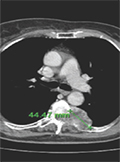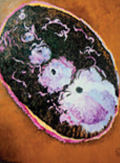The eLitMed.hu medical portal uses computer cookies for convenient operation. Detailed information can be found in the Cookie-policy.
Lege Artis Medicinae - 2014;24(10-11)
Content
[The prevalence of musculoskeletal symptoms among ambulance personnel in a national subsample]
[BACKGROUND - The ambulance workers face a lot of mental stress and physical demands in their everyday life. The physical demands can be originated from caring heavy equipment and moving patients. The poor mental health can strengthen physical problems, too. In this study our aim was to detect and compare the musculoskeletal status of ambulance personnel in two regions of Hungary. SAMPLE AND METHODS - On a voluntary base a cross-sectional anonymous, standardized self-fill-in questionnaire (Nordic Musculoskeletal Questionnaire) was used with additional items. All ambulance personnel over 18 years old were involved in the study who worked in direct patient care either in the North-Hungarian or in the West-Hungarian Region of the country. RESULTS - In the regional representative sample N=810 workers answered our questions. Out of them 587 persons (72.5%) reported about some musculoskeletal problem during his lifespan. Most of them suffered from lower back pain (448 persons, 55%), back pain (318 persons, 39%), neck pain (250 persons, 30.9%). Parallel with the aging and with the time spent working for the ambulance service more and more overall discomfort can be detected (p=0.013; p=0.020). Having a second job affected the level and frequency of discomfort negatively (p=0.005). CONCLUSIONS - More than 70% of the ambulance workers experienced musculoskeletal problem during his emergency workers carrier which may worsen the quality of his work and his personal life. To handle the situation primary prevention, screening and possibilities for recreation should be forced among ambulance workers. ]
[Education and psychological support of parents in cases of postnatally detected Down syndrome]
[OBJECTIVE - Since the 60’s several publications dealt with the phenomenon how physicians inform parents of newborns about postnatal recognition of Down’s syndrome and the support they receive right after breaking the bad news. Howe - ver, the rest of these studies concentrated on surveying parental satisfaction, while relatively few international studies deal with the other side of the communicational situation, the opinion of the informer. Our study focused on the circumstances of parental information in Hungarian institutions of obstetrics in order to evaluate the possibilities for interventions. METHODS - The Down’s team operating at the University of Pécs Faculty of Health Sciences carried out a national survey in 2005 - an interview-based questionnaire filled by physicians of institutions of obstetrics - with the help of the National Register for Congenital Diseases of the National Centre for Epidemiology and Down’s Foun dation. RESULTS - The coverage of the survey reached 74%. Rest of the surveyed institutions did not have information protocol, however, 70% of them believes it would be necessary. Only 44% of the physicians received communication training and 81% of them believe they can manage communication, 33% have felt that the mother of a newborn with Down’s syndrome would expect special help that the institutions are unable to provide. CONCLUSION - There are serious problems with the circumstances of parental informing in Hungarian institutions of obstetrics. This situation would obviously require intervention. An aimed communicational training based on international experience and exploiting the openness of physicians, as well as the establishment of information protocol could be elements of such intervention.]
[Investigation of vitamin D supply in hospitalized patients]
[Recent studies have shown that adequate vitamin D level is essential in the maintenance of normal immunological status and presumably, it has a remarkable role even in the healing of some diseases. Vitamin D deficiency is a common phenomenon worldwide. Presently, the accepted marker of vitamin-D status is the total-25-hydroxy- D-vitamin [t-25(OH)D], its level depends on the specific (DBP) and aspecific (albumin) binding proteins. As known, the level of binding proteins may change in the hospitalised patients therefore, the presently used marker could not be reliable for the vitamin status in these cases. Our aim was to measure the D-vitamin supply among hospitalized patients, taking into account the level of binding proteins. METHODS - 401 cases (average age 70±14 years) were sorted from Internal Medicine (IM; 68), Intensiv Care Unit (ICU; 58), Traumatology (203 patients suffered hip fracture) and Dialysis Center (72 patients with end stage renal disease). 127 age and sex matched persons with active lifestyle served as control group. We determined t-25(OH)D, DBP, parathormon (PTHi), albumin and the albumin corrected Ca level. The bioavailable and free vitamin fractions and the free index were calculated. RESULTS - Based on the measured t- 25(OH)D, patients have more frequently suboptimal D-vitamin levels, compared to the control group (66% vs. 97%). Severe Dvitamin deficiency occured nearly 8 times more likely (6% vs. 47%) in the hospitalized patients. Chronic renal failure and malignant diseases seem to be significantly negative influencing factors in the metabolism of the vitamin D. The level of DBP, albumin, t-25(OH)D, Bio-25(OH)D was significantly lower in the patients who died. CONCLUSION - In most cases, t-25(OH)D levels show similar results about the vitamin- D supply than other calculated 25(OH)D fraction ,except for the patients of ICU and IM . The t-25(OH)D, the Bio- 25(OH)D, the DBP and the albumin levels seem to be a good prognostic marker of the outcome.]
[How can the fixed-dose atorvastatin/amlodipin combination help better adherence of patients to therapy?]
[Among the main risk factors of cardiovascular disease which is the leading cause of death dyslipidemia has a great importance beyond hypertension, diabetes, smoking and obesity. These conditions rarely occure as isolated ones but very often a clustering of major CV risk factors within individual patients can be observed called metabolic syndrome. It’s a great challenge to convince asymptomatic but high-risk adults that they have to take a lot of medicine for a long time period uninterruptedly to prevent future vascular events (eg. MI or stroke) in the primary care settings. Mainly the low statin-adherence means the greatest problem particularly if a subject should take statin beside two or more drugs despite statins have the most prominent evidences in the field of cardiovascular prevention. The efficacy in improving adherence to therapy of fixed-dose atorvastatin/amlodipin combination was investigated in this paper based on the experiences of case reports derived from our clinical practice.]
1.
Clinical Neuroscience
[Headache registry in Szeged: Experiences regarding to migraine patients]2.
Clinical Neuroscience
[The new target population of stroke awareness campaign: Kindergarten students ]3.
Clinical Neuroscience
Is there any difference in mortality rates of atrial fibrillation detected before or after ischemic stroke?4.
Clinical Neuroscience
Factors influencing the level of stigma in Parkinson’s disease in western Turkey5.
Clinical Neuroscience
[The effects of demographic and clinical factors on the severity of poststroke aphasia]1.
2.
Clinical Oncology
[Pancreatic cancer: ESMO Clinical Practice Guideline for diagnosis, treatment and follow-up]3.
Clinical Oncology
[Pharmacovigilance landscape – Lessons from the past and opportunities for future]4.
5.


















